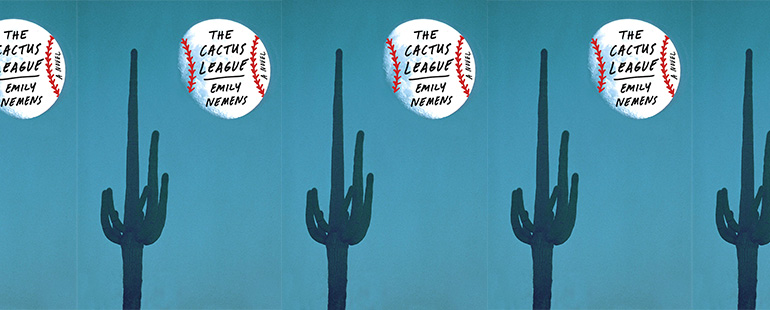The Cactus League’s Sense of Control

On the last day of February 2020, I boarded a flight to Arizona, relishing in the promise of a week of baseball in the desert after a bleak Pennsylvania winter. Emily Nemens’s The Cactus League, published shortly before the trip, provided a perfect travel companion. The book comprises nine stories constellated around the plight of Jason Goodyear, baseball superstar and secret gambling addict, all yoked together by nine interstitial “innings” spoken by an out-of-work sportswriter who is unearthing Jason’s story.
Now two years out from the book’s launch, two years into a global pandemic, and mere days from discovering whether Major League Baseball’s owners will come to an equitable solution with the players in time for spring training to proceed unimpeded, Nemens’s work pulls me again, not simply in longing for the summer game, but in the book’s reflections on control. Midweek during that 2020 trip, while leaving a Giants game at Scottsdale Stadium, we walked past HonorHealth Scottsdale Osborn Medical Center where the crowd whispering around us said it was rumored there was a patient afflicted with the novel coronavirus. Seventy-two hours later we flew home, uneasy and unsettled, and into this ongoing spiral of uncertainty and powerlessness in which doing everything “right” still doesn’t offer any concrete sense of control.
The nature of Spring Training, for many baseball players, is also uncertainty. Baseball is a team sport constructed of individual performances; every play, every swing is a spotlighted solo that offers up the illusion of assurance: play well and the rest will take care of itself. There are, however, more forces with which to contend.
In “Wedge Shot,” skilled centerfielder Trey Townsend, one of the cornerstones of the Lions’ lineup, betrays the trust of one of the team’s owners and finds himself traded away from the team without warning. The intended arbiter of success—on-field performance—is not only not enough to save Trey, it’s barely considered. As a friend, one-time lover, and professional project to partial team owner Stephen Smith, Trey stands inside a complex relational web. Over the course of Trey and Smith’s relationship, Smith has acted as a kind of guide, ushering Trey into a community of successful Black men in a predominately white world. Smith teaches Trey how to control his appearance for his audience: “Wear dark colors, conservative brands, to make yourself seem less imposing in mixed, or otherwise sensitive, company.” But theirs are also separate communities—owners and players. Trey’s choice to not share both news of Jason Goodyear’s misdemeanors and his intimacy with one of the Lions’ new players with Smith is the bridge too far. Smith cannot control Trey’s choices as they pertain to Smith, but he can control where Trey plays. Not here.
These human dramas play themselves out across every one of the stories as characters are placed, again and again, on a precipice that far outweighs the outcome of any game. It makes for a dynamic and compelling reading experience as the stories pull in the arcs of not only members of the Lions organization but also wives and girlfriends, stadium staff, and people simply swept up by some of the more outsized personalities showcased in the book.
But there is a larger consideration of control made manifest in The Cactus League’s very structure. That The Cactus League is Jason Goodyear’s story—emotionally, dramatically—is clear. The unnamed sportswriter who shepherds the reader along, however, through his positioning and control of the story’s unfurling, attempts to make the teller at least as important, if not more important, than the tale.
Let go in the wave of newspaper shutterings and media upheavals of the 2009 recession, the sportswriter sets out—two years later—to make a big scoop out of Jason Goodyear’s implosion. He says, to a reader posed as confidant and co-conspirator, “Now I’m no muckraker, and not setting out to take down a great man, but in this life things are complex, some questions are hard, and that’s why I drove to Arizona in the first place.”
In the book’s interstitial “innings,” the sportswriter fashions himself as a guide to both the Cactus League environs and the events unfolding, one with privileged insider knowledge. The reader, as much in pursuit of the story as the sportswriter, is positioned to feel grateful for the information. That gratitude is amplified by the occasional open-endedness of the stories’ action. In the second story of the book, “Prospects,” Tami Rowland, connoisseur of baseball and baseball players, has a gin-soaked dinner with Jason Goodyear that leads them to Taliesin West, a Frank Lloyd Wright property perched on the northeast edge of Scottsdale. Tami succeeds in drawing Jason out: he admits to his obsession with competition, with winning. Later, perhaps leaning a bit on his desire to succeed at any action, even one as trivial as throwing rocks, Tami incites Jason to use his All-Star arm to knock out the museum’s security camera. While she plunders the gift shop where she used to work, Jason, unattended and unobserved, continues throwing rocks. Suddenly, the whole complex goes dark, and the story ends with Tami seeing the foreboding red and blue of police car lights on the horizon. On one hand, the closing image might be clue enough to the outcome, but Tami’s car is still in the lot and they have all this darkness as a shroud. Getting caught is not inevitable. But the story ends, and, instead, the sportswriter is the one to reveal their apprehension and Jason’s trespassing charge, in “Third.” There, he conveys not only Jason’s agent’s reaction but also the reactions of team staff and Jason’s ex-wife, Liana.
Narratively, these revelations fill in necessary elements of the plot and amplify drama. On occasion, however, the sportswriter uses his authorial position to reveal an outcome ahead of time, even at the expense of tension. At the close of “Fifth,” the sportswriter says, after one of his many extended geologic metaphors: “Like Greg Carver: he was cut before he ever had a chance.” The story immediately following, “Cut Meeting,” relates Carver’s attempt to earn a spot on the big league roster following a failed Tommy John surgery. It must be said that there’s not a great deal of hope for Carver on offer: in the story’s first paragraph, readers meet him deep into a spring training start and so disoriented from the painkillers he can’t remember the name of his longtime friend and catcher. The ill-fated opening makes the sportswriter’s preemptive pronouncement that much more unnecessary, as Greg Carver’s plot is concerned, but it is absolutely necessary to demonstrate the sportswriter’s narrative power. The preempt is a mediation and an assertion: he knows more than he lets on, which points to an increasing complexity in the sportswriter’s position in the broader arc of the book.
The sportswriter freely shares the limitations of his own first-person narration: “What does a sportswriter do without his badge?” he asks in “Second.” “Loiter around the parking lot, that’s what, watching for players to come out of the clubhouse, hoping he can launch a question over the heads of the shortstop-sized kids waiting for signatures . . . He’s not a hell of a lot different than Tamara Rowland, truth be told.” But like Tami, he appears to make his own opportunities, and by giving away Carver’s ending before the story arrives, he makes it possible for the reader to imagine him in the margins of the stories, rather than remaining confined to the interstitial innings.
Earlier passages bear this out, as he implicates himself in actually being present for much of the stories’ action. In “Fifth,” he tells us, “Sara’s not the only one to see him scuttling back across the bridge between the casino and the field, late for his seven a.m. date; I’ve seen it, too.” Sara, the unlikely live-in personal assistant and caretaker to Jason’s agent, has become part of the sportswriter’s investigative scrutiny. What he has not seen with his own eyes, he has asked after. He speaks to casino employees who tell him how deep a hole Jason has dug for himself, and this strikes a reader as sensible journalism. But he is not above resorting to an ethical gray area as he does his own digging: “The whole month of November, he was never once home for dinner. Liana didn’t tell me that detail, but her housekeeper was happy enough to share it in exchange for a hundred-dollar bill.” He bribes Sara for information, too, taking advantage of her history of financial precarity. He also admits to manipulation while seeking information on Jason’s rumored divorce: “A source,” he says, “and not just a wined-up left fielder, confirmed they’re split.”
Perhaps the most visceral and even damning demonstration of the sportswriter’s dedication to controlling the narrative—which is to say centering himself in it—arises in the final story, “Triple Play.” Now the reader is finally perched on Jason’s shoulder, rather than watching him through another character’s eyes, and something, for Jason, has got to give. He has extorted a teammate for funds to pay off one dangerous debt collector and has lost his beloved Jeep in the same moment. Desperate, still grievously indebted, he makes his way—late—to the stadium. Hurrying through the parking lot, he sees a boy asleep in a closed-up car baking in the desert heat. Jason, who has fallen so far, nevertheless rises here: without considering what the glass could do to his hand—which is to say his playing career and the only thing properly remaining to him, his only path out of his troubles—he breaks the window, rescues the boy. And once the boy is out of the car—imagine a pietà, bleeding player and heatstroked child—the sportswriter breaks into the narration. He writes, “That’s when I come over, too, having been trailing Jason at an inconspicuous distance all morning—the shed with Goslin, the bank visit, the Whole Foods handoff, back to the stadium. . . . My reaction is relief, relief that help is coming. And, if I’m being honest, there’s a bit of selfishness there, knowing I won’t have to watch someone die today.” The sportswriter offers his own shirt to wrap Jason’s cut hand and interprets the ending for his own concluding paragraphs: “‘Hang on,’ he says again. Jason Goodyear means it as some sort of hope for that wilted, red-faced kid in his arms, but goddamn it if his words couldn’t have been meant for himself, if they couldn’t have been meant for us all.” That strange attempt at absolution—he won’t have to watch anyone die—rings oddly, as though he could not have acted as much as Jason could have. He is, after all, right behind Jason, and this is a boy he knows: little Alex S., who is Jason’s ex-wife’s student, whose mother sells concessions in the stadium, and who is, in his own unknowing way, another source.
In reviews of The Cactus League, the sportswriter’s sections have received mixed reactions. His metaphors are overblown, his voice a little too try-hard. But that assessment side-steps the fascinating rhetorical moves inherent in the space he takes up and how he does so, which is another enticingly crafted aspect of Nemens’s book. The story lives with Jason, but in the telling of it lies the sportswriter’s own redemption, or validation. Of course he must have the last word.



